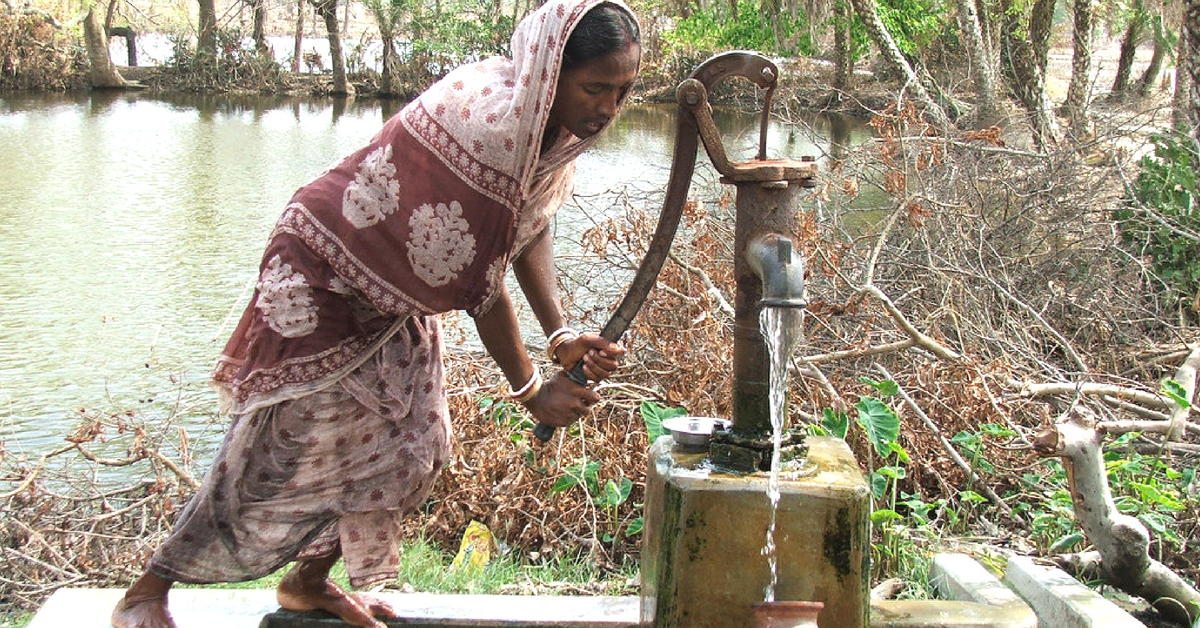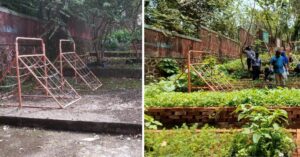The Politics of Groundwater: Who Has How Much Stake in What
Dr Himanshu Kulkarni and Uma Aslekar explain why, in order to make access to water adequate and equitable, we must shift our focus from water sources to water resources. Both science, and community participation and cooperation, are key to addressing our water woes.

A growing demand for water implies the need for an improved understanding of our resources, and the ability to manage that demand in an equitable and sustainable way.
Wells, not dams, have been the temples of modern India

Picture for representation only. Source: Wikimedia
India is a groundwater economy. At 260 cubic km per year, our country is the highest user of groundwater in the world–we use 25 percent of all groundwater extracted globally, ahead of USA and China.
When we think of water however, our brains have been programmed to think of large dams and rivers, and not wells. This, despite the fact that India has at least four crore irrigation wells and millions of farmers who use well water in agriculture.
India was not the highest extractor of groundwater in the 1960s and 70s; the Green Revolution changed that. At independence, the share of groundwater in agriculture was 35 percent; today it is a startling 70 percent.
Looking at water as a common pool resource
People tend to think of groundwater only through an agriculture or urban water supply lens. This however, is just a supply-side perspective that lacks an understanding of what the resource is, and what we need to do to ensure better use of it.
We need to think of groundwater as a common pool resource; the challenge, however, is that this common pool resource is almost invisible.
In villages, the perception often is, “This is my land and hence the water below it is my water.” But the question we’ve been asking communities to think about is, “How can you own the water below your land, when the water in your well has come from underneath someone else’s land and the water from under your land is naturally going to flow underneath your other neighbours’ lands?”
Once this has been explicitly stated and explained, people are quick to understand it especially if you use science derived from data that has been collected by communities themselves.
But while the science is about hydrogeology and the mapping of water sources, the more important aspect is the application of this science – which is effective only if it involves bringing the resource (aquifers) and communities together in the processes and solutions – what we call Participatory Ground Water Management (PGWM).
Thinking about water as a resource and not just a source

The conventional thinking is that check dams–which are essentially percolation tanks–will collect water that will percolate and recharge the groundwater. A common misconception among both the communities as well as organisations working in watershed management is that it is the wells that are being recharged.
But wells are only the sources of water and a mechanism to access water and distribute it according to needs and often, demands. Wells are not the resource; aquifers are the resource. (Aquifers are underground layers of porous and permeable rock, capable of storing groundwater and transmitting it to wells and springs.)
If you can identify your aquifer, then you know precisely where to put your recharge structure (or, check dam). So now, instead of four check dams that you would place in areas where ‘water collects’, you could make do with two accurately positioned check dams where the aquifers are, thereby reducing costs by half while also ensuring optimal recharge.
Usually, once the watershed programme is implemented, no one cares about what happens to the water in the aquifer. Farmers tend to dig deeper, make larger wells with the presumption that unlimited water is now available for the taking. Such actions are not necessarily sustainable.
It is therefore important to move the focus from wells (sources) to aquifers (resources). By changing this lens, the focus then shifts from merely looking at what is going in and coming to a variety of aspects: How do you balance livelihoods and ecosystem needs, or what happens to economic returns from groundwater and how does the drinking water security get affected when an aquifer depletes.
Communities need to have this knowledge
Having understood the theory and implications behind aquifers and ground water, communities and villages have been keen on getting trained in these areas. Imparting these key hydrogeological skills to nonprofits and rural practitioners is therefore key to improving decentralised water management in India.
Over the last 20 years, we at ACWADAM, have trained para workers within communities. These individuals are now able to intelligently design the watersheds, talk to their communities, monitor progress, and ensure better decision-making and management of groundwater.
As a result, communities are more aware of the uses of check dams – why they are built in specific locations, what their purpose is, and what that will mean for the villages.
Panchayats are also now asking for knowledge and help. They are even willing to pay for the costs incurred, which for us, signals just how important this is to the village as a whole.
The decisions on water should rest with the people

90 percent of rural India’s drinking water comes from groundwater and 75 per cent of agriculture is groundwater-based. In urban India, 50 percent of the water supply is groundwater-based.
Given this high dependence on groundwater, it is extremely important that we bring democratic processes to groundwater management. When we share our hydrogeology results with communities, we at ACWADAM don’t influence the decisions, we don’t tell them what to do.
We share the results – this is saline and is a larger aquifer; this other one has fresh water and gets used faster. And we give them ‘protocols’ – a menu of possible options to decide upon. We tell the villagers that these are the limitations, and these are the possibilities.
This information serves as a starting point for a dialogue. The community then decides what they should do and what they should avoid.
When communities collect data and you derive knowledge from that data, they will trust the data. And they are more likely to change their behaviour and practices. When you move the decision-making and power to the people themselves, change is not as difficult as we make it out to be.
It also then becomes change that is based on scientifically informed decisions; there is seldom total failure from such decisions.
Since it’s about water, there are always power dynamics at play
The science of groundwater is not only about hydrology; it’s sociology, psychology, politics, economics and ecology as well. The power dynamics around sharing are about people as well as the stakes involved–who has how much stake in what. The landless have more stake in ecology, the large farmers have a stake in economics, the small marginal farmers in sociology.
The first step towards getting people to even think about sharing is to have them cooperate in some formal-informal capacity. Unless people and communities cooperate, you can’t protect the resource, you can’t make it sustainable.
It, therefore, needs good governance

Surface water is typically characterised by conflict–who’s getting what water, how much, where is it coming from, do we want to bring it from further and further away. Being above ground and visible, people are quick to fight over it!
With groundwater, there is limited conflict; instead, people compete with each other because one can compete endlessly over invisible resources; you can go deeper, and you can have as many water sources as you want on your land.
Our social narratives, in fact, are built around groundwater. The woman of the house who manages drinking water and her husband who handles agriculture are often managing water from two different sources for two different activities. Often, these sources tap the same aquifer. Hence, the couple are in tacit competition without being aware that they are; both their needs are met by the same underlying aquifer. So, if you use up too much water for agriculture, then drinking water is a problem and scarcity results. How do you tackle this?
All of this, therefore, needs good governance and good management. And governance itself is based on science, participation management and institutions in the village. The Panchayat, which usually makes these decisions, is therefore critical to the success of this approach. We don’t go and work in an area unless we have formal permission from the Panchayat.
This approach needs more supporters
Participatory groundwater management needs more support. Corporates often say that it is a high hanging fruit – since it is dependent on the annual rain-cycle, it takes a year for the research/hydro-geological study, and only then can any of the actual work start on building check dams or changing usage patterns. The results take time to ‘show’.
Moreover, results are usually in the form of aggregated small changes—drinking water security, improved crop yields and so on–and given the invisible nature of the resource itself, these visible changes are often difficult to perceive. However, such changes are longer lasting, making the effort sustainable and efficient.
It is much easier to invest in the digging of bore wells and building of tanks. But if we, as a nation, want to ensure that the access to water is adequate, equitable, and sustainable, we must look at both science and community participation for answers, rather than building more and more infrastructure in pursuit of visibility.
This shift is perception will go a long way in changing the way we look at groundwater in India.
—
About the authors:
Dr Himanshu Kulkarni is the executive director and secretary at Advance Centre for Water Resources Development and Management ACWADAM, Pune. He has been actively involved in the advocacy for stronger programmes on groundwater management in India, through his inputs, more recently as Chairman, Working Group on Sustainable Groundwater Management for India’s 12th Five Year Plan.
Uma Aslekar is a senior scientist with ACWADAM. She has been working with ACWADAM since 2002. A geographer by education, Ms Alsekar completed her M.Sc. in Geomorphology from the University of Pune.
—
Featured image for representation only. Source: Flickr
This article was originally published on India Development Review. You can view it here.
Like this story? Or have something to share? Write to us: [email protected], or connect with us on Facebook and Twitter.
NEW: Click here to get positive news on WhatsApp!
This story made me
- 97
- 121
- 89
- 167
Tell Us More
We bring stories straight from the heart of India, to inspire millions and create a wave of impact. Our positive movement is growing bigger everyday, and we would love for you to join it.
Please contribute whatever you can, every little penny helps our team in bringing you more stories that support dreams and spread hope.



















